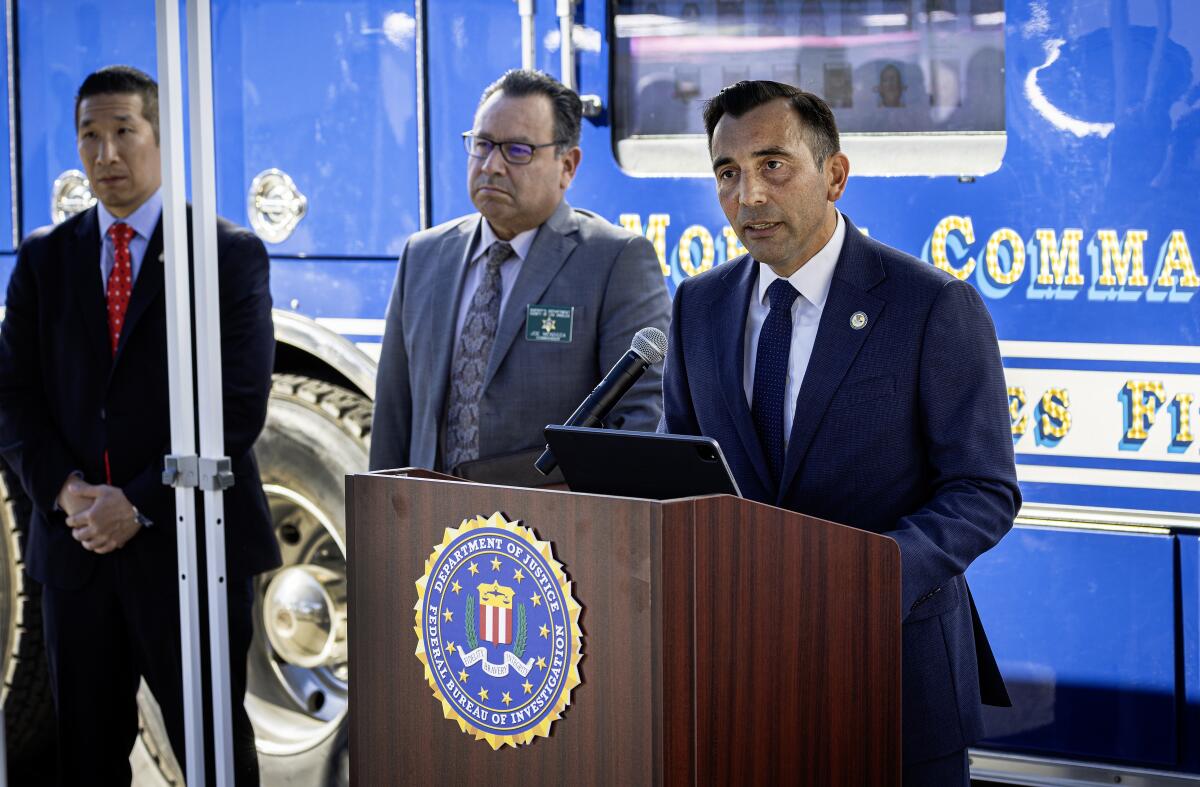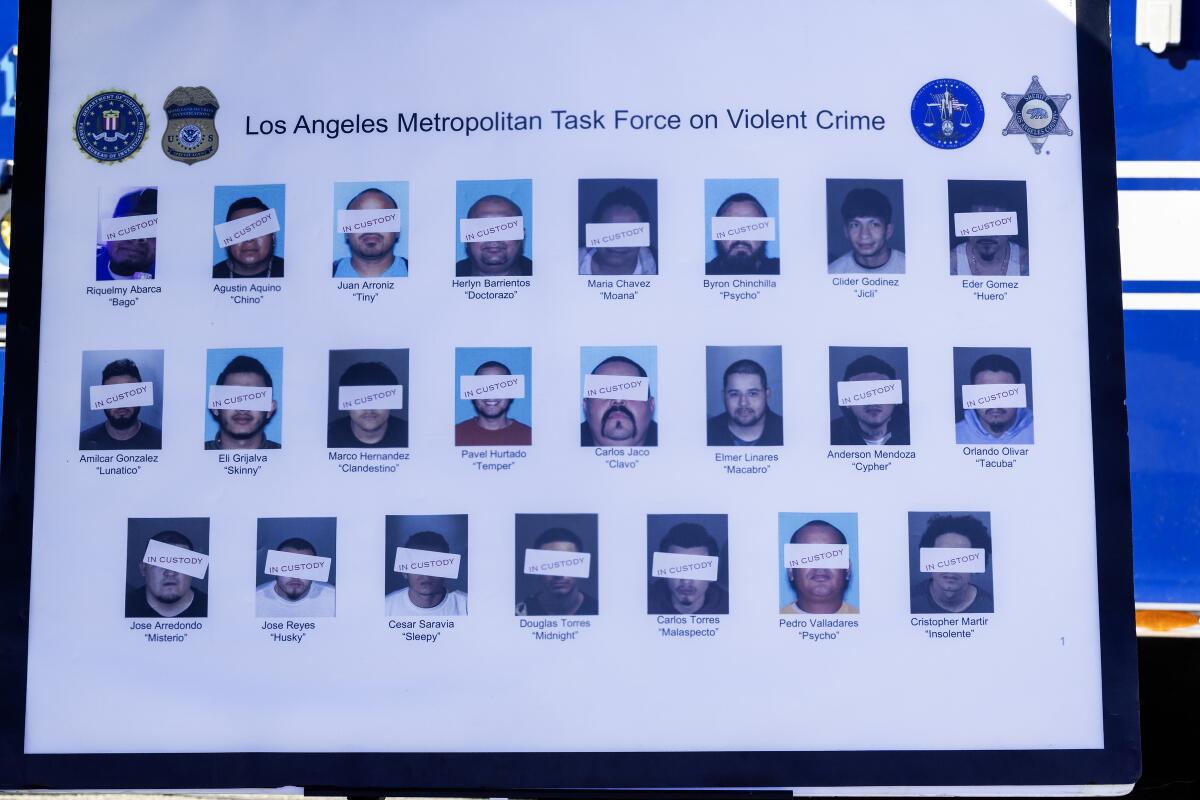Federal prosecutors charge MS-13 drug suspects linked to Mexican Mafia leader

- Share via
Federal prosecutors in Los Angeles charged 23 alleged members and associates of the MS-13 gang in a conspiracy to traffic methamphetamine, authorities announced Tuesday.
Speaking at a news conference in downtown L.A., E. Martin Estrada, the U.S. attorney for the Central District of California, called drug sales “the lifeblood” of the gang, which was born 40 years ago in Los Angeles before deported members carried it back to their home countries of El Salvador, Honduras and Guatemala.
In California, prosecutors said, MS-13 answers to the Mexican Mafia, an organization of about 140 men who control Latino gang members on the streets, in county jails and in state and federal prisons.
The grand jury indictment charges that a Mexican Mafia member controlled MS-13’s drug sales from prison, requiring the “shot callers,” or supervisors of each of the gang’s 20 cliques in Los Angeles, to buy methamphetamine from Herlyn “Doctorazo” Barrientos, 46, of Huntington Park.
The shot callers either sold the drugs themselves to raise funds for their cliques, or distributed the narcotics to dealers who paid a “tax” to the gang, Estrada said.
Although the Mexican Mafia member wasn’t charged or named in the indictment, Estrada identified him as Ray Martinez. A member of MS-13’s Fulton clique nicknamed Cisco, Martinez, 50, has been in state prison since 1996 serving a sentence of life without parole for murder and robbery, records show.

“It was better to leave him with an LWOP [life without parole] sentence,” Estrada said.
In July, prison officials identified Martinez as one of two assailants who stabbed to death Michael Torres, a Mexican Mafia member from San Fernando called Mosca, at California State Prison, Sacramento. Law enforcement authorities considered Torres the dominant figure in the Los Angeles County jail rackets, which he oversaw from his prison cell using contraband cellphones.
The other man accused of killing Torres, Juan Martinez, is an admitted member of the Ontario Black Angels gang, according to parole records. He is not related to Ray Martinez.
Adrian Franco, who leads the FBI’s Los Angeles field office, said 400 agents, detectives and officers served 19 arrest warrants and five search warrants early Tuesday morning in Los Angeles, Palmdale, Lancaster and Oxnard, seizing five handguns, four rifles and $90,000 in cash, along with methamphetamine, fentanyl, cocaine and marijuana. Two of the defendants, Elmer Linares and Clider Godinez, remain at large, Franco said.
Estrada said MS-13, whose cliques are based in historically immigrant neighborhoods such as Westlake, Pico-Union, Koreatown and Hollywood, “preys on its own people” by selling high-purity methamphetamine.
The gang extorts its neighbors and recruits teenagers, a path that can only lead to death or prison, he added. “The reality is there is no glory with MS-13.”
The federal indictment comes at a strained point in the relationship between MS-13 and the Mexican Mafia.
MS-13 members on the streets of Los Angeles — and those in the county jail and California prison system — still pay taxes to and take orders from the Mexican Mafia. But in the federal system, which has received an influx of MS-13 members from across the country after recent waves of prosecutions, nearly all MS-13 inmates are being held for their own protection at a single penitentiary in Lewisburg, Pa., according to sources who requested anonymity because they were not authorized to discuss prison security arrangements.
The MS-13 segregation policy follows an incident on Jan. 15, 2020, when two MS-13 members at the U.S. Penitentiary in Lee, Va., entered the cell of Anthony “Coco” Zaragoza, a special agent for the U.S. Bureau of Prisons testified at a hearing in 2022.

A member of the rival 18th Street gang serving life in prison for a series of Los Angeles murders in the 1990s, Zaragoza was inducted into the Mexican Mafia after entering the federal prison system, according to investigative records reviewed by The Times.
While a third MS-13 member held the cell door shut and fought off inmates who came to Zaragoza’s aid, the two MS-13 members inside stabbed and beat Zaragoza nearly to death, according to testimony. Photographs taken after the assault showed that the cell’s walls were smeared with blood and a sink had been ripped out of a wall in the chaos.
Zaragoza’s assailants told investigators they’d been plotting the attack for months, believing the Mexican Mafia had shown a lack of respect toward MS-13. One said Zaragoza asked for a list of MS-13 inmates with life sentences — the implication being they wouldn’t be concerned with picking up a new case — who could assault guards if Zaragoza were sent to solitary confinement or “messed with” by staff, according to a report of the interview.
“Just wait,” the MS-13 member told investigators. “We aren’t the only ones that will turn away from the Mexican Mafia.”
“We live and die MS, this is our family,” another of the attackers declared. “Zaragoza disrespected us as men and he is supposed to be above that.”
At the sentencing of one of Zaragoza’s assailants, a federal prosecutor said the attack “lit a fuse” that led to more violence and “prompted a nationwide investigation into the fractured relationship between these once aligned gangs.”
Two years after Zaragoza was nearly killed, seven MS-13 inmates at the U.S. Penitentiary in Beaumont, Texas, attacked a group of Sureños, gang members who answer to the Mexican Mafia. Two Sureños — Guillermo Riojas and Andrew Pineda — were stabbed, beaten and stomped to death. The violence prompted a nationwide lockdown of the federal prison system for nearly a week, officials said.
More to Read
Sign up for Essential California
The most important California stories and recommendations in your inbox every morning.
You may occasionally receive promotional content from the Los Angeles Times.













